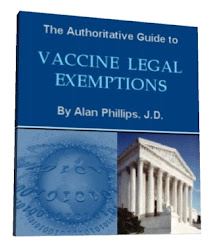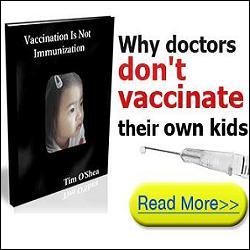Professor Reveals Shocking Report On Flu Vaccinations
![]() Arjun Walia, Collective-Evolution
Arjun Walia, Collective-Evolution
Waking Times
It’s great to see more “academics” that openly push and encourage the world’s biggest pharmaceutical companies to open their records to outsiders in an effort to better understand the potential harmful consequences of the drugs that billions of people across the world take everyday.
Should the transparency of drugs and vaccines that millions of people take every year not be a given? Unfortunately it’s not. This can be a scary thought, the fact that modern day health care is not transparent at all, often leaving patients and medical professionals completely in the dark and unaware when it comes to the truth about these things.
Pharma Hiding Information
It’s be revealed many times that pharmaceutical companies and vaccine manufactures purposely withhold critical information and data from the public domain when it comes to their products. One great example (I’ve used many times) comes from documents obtained by Lucija Tomljenovic, a PhD from the Neural Dynamics Research Group in the Department of Ophthalmology and Visual Sciences at the University of British Columbia, Canada. The documents reveal that vaccine manufacturers and pharmaceutical companies, as well as (some) health authorities have known about multiple dangers associated with vaccines, but chose to withhold them from the public for decades. (1)
Unfortunately, this is also quite common when it comes to modern day health care products, not just drugs. For example, earlier this year a chemical called triclosan found in one of North America’s most popular toothpastes, Colgate Total, was linked to cancer and other harmful health ailments. Documents were kept from view of the public eye showing that the scientific findings that Colgate put together to establish the chemicals safety weren’t clear at all. These documents were not made available to the public domain until this year. (2) You can read more about this story in detail here.
As the New York Times points out, according to activists:
“The current system, the activists say, is one in which the meager details of clinical trials published in medical journals, often by authors with financial ties to the companies whose drugs they are writing about, is insufficient to the point of being misleading.” (4)
“This problem has been very well documented for at least three decades now in medicine, with no substantive fix” (4)
Another article you might want to check out regard fraud and the CDC is this: New Study Finds A 340 Percent Increased Risk of Autism In Boys Who Receive MMR Vaccine On Time
The Report
 One great example is the Influenza vaccine. In 2013, Dr Peter Doshi published a study in The British Medical Journal (BMJ) titled Influenza: Marketing Vaccine By Marketing Disease. A former post doctoral fellow at John Hopkins University and now an Assistant Professor at the University of Maryland’s School of Pharmacy. He is also an associate editor at the BMJ. His research focuses on policies related to drug safety and effectiveness evaluation in the context of regulation, evidence-based medicine, and debates over access to data. (source)
One great example is the Influenza vaccine. In 2013, Dr Peter Doshi published a study in The British Medical Journal (BMJ) titled Influenza: Marketing Vaccine By Marketing Disease. A former post doctoral fellow at John Hopkins University and now an Assistant Professor at the University of Maryland’s School of Pharmacy. He is also an associate editor at the BMJ. His research focuses on policies related to drug safety and effectiveness evaluation in the context of regulation, evidence-based medicine, and debates over access to data. (source)
The main argument of the paper points to the fact that the CDC pledges “To base all public health decisions on the highest quality scientific data , openly and objectively derived,” and how this isn’t the case when it comes to the influenza vaccination and its marketing.
“The vaccine may be less beneficial and less safe than has been claimed, and the threat of influenza seems to be overstated.”(3)
Today, there are approximately 135 million doses of the influenza vaccine that enter the United States market alone every single year. In 1990, there were approximately 30 million. Dr Doshi argues (and provides evidence) that this exponential rise in vaccination production does not stem from the need for it, or the demand for it, but rather by a public health marketing campaign that delivers “a straightforward, who in their right mind could possibly disagree message: influenza is a serious disease, we are all at risk of complications from influenza, the flu shot is virtually risk free, and vaccination saves lives.” (3)
It’s great to see Dr. Doshi speak out this mass marketing campaign. Through this type of marketing, there are those who feel opposing the vaccine is unethical, which is absolutely ridiculous. It seems those who do chose to take the influenza vaccine, do so as a result of heavy marketing. Every year we see a large amount of propaganda that tends to convince people the flu vaccine is extremely safe and necessary. A simple pharmacy radio advertisement or television (programming) commercial can do the trick, encouraging people to get the vaccine without doing any research, putting blind faith where it shouldn’t be put. Here is a great example that Dr Doshi points out in his paper:
“At a press briefing this winter, CDC director Thomas Frieden said a preliminary CDC study had found “the overall vaccine effectiveness to be 62%.” He explained that this estimate of relative risk reduction: “means that if you got vaccinated you’re about 60% less likely to get the flu that requires you to go to your doctor.” On the evening news, the CDC’s message was translated into a claim that influenza vaccines will cut the risk of death by 62%, despite the fact that the CDC study did not even measure mortality (box 2). Reflecting on the same CDC study, two authors editorialized in the Journal of the American Medical Association that there exists an irrational pessimism about influenza vaccine: “A prevention measure that reduced the risk of a serious outcome by 60% in most instances would be a noted achievement; yet for influenza vaccine, it is seen as a ‘failure.’” (3)
If you look at the science, the mass marketing by health authorities and drug manufacturers seems to be very misleading. Not that surprising, is it?
 It’s clear that the majority of people, more so in North America, oppose the flu vaccination. As a result, the only way to maintain and keep vaccination numbers up is to implement mandatory vaccination programs. (5) How mandatory vaccination requirements, especially in health care facilities is seen as something ethical, and encouraging others to look at the science outlining potential dangers associated with the vaccine is seen as unethical is mind altering.
It’s clear that the majority of people, more so in North America, oppose the flu vaccination. As a result, the only way to maintain and keep vaccination numbers up is to implement mandatory vaccination programs. (5) How mandatory vaccination requirements, especially in health care facilities is seen as something ethical, and encouraging others to look at the science outlining potential dangers associated with the vaccine is seen as unethical is mind altering.
Dr Doshi cites the papers the CDC commonly uses to support the complete safety of the influenza vaccine, more specifically in older people. In doing so, he also points to the CDC’s national guidelines, a 68 page document that includes over 500 references. He claims that the studies cited in this document are undermined by bias, and that the agency itself acknowledges the fact that they may be undermined by bias.
“Studies demonstrating large reductions in hospitalizations and deaths among the vaccinated elderly have been conducted using medical record databases and have not measured reductions in laboratory-confirmed influenza illness. These studies have been challenged because of concerns that they have not controlled adequately for differences in the propensity for healthier persons to be more likely than less healthy persons to receive vaccination.” (Fiore AE, Uyeki TM, Broder K, Finelli L, Euler GL, Singleton JA, et al. Prevention and control of influenza with vaccines: recommendations of the Advisory Committee on Immunization Practices (ACIP), 2010. MMWR Recomm Rep. 2010;59(RR-8):1-62.) (3)
If these observational studies cannot be trusted, what evidence is there?
“This means that influenza vaccines are approved for use in older people despite any clinical trials demonstrating a reduction in serious outcomes. Approval is instead tied to a demonstrated ability of the vaccine to induce antibody production, without any evidence that those antibodies translate into reductions in illness.”(3)
The paper also points to the fact that no evidence exists, however, to show that this reduction in risk of symptomatic influenza for a specific population—here, among healthy adults—extrapolates into any reduced risk of serious complications from influenza such as hospitalizations or death in another population (complications largely occur among the frail, older population).
 “Marketing influenza vaccines thus involves marketing influenza as a threat of great proportions.”(3) Again, it’s great how the paper outlines this theme throughout. It also outlines how how recorded deaths from influenza declined sharply over the middle of the 20th century, and that this occurred before the great expansion of mass vaccination campaigns at the start of the 21st century.
“Marketing influenza vaccines thus involves marketing influenza as a threat of great proportions.”(3) Again, it’s great how the paper outlines this theme throughout. It also outlines how how recorded deaths from influenza declined sharply over the middle of the 20th century, and that this occurred before the great expansion of mass vaccination campaigns at the start of the 21st century.
Another marketing strategy used to push the flu vaccine is the claim by vaccine manufactures that “flu” and “influenza” are the same. The paper outlines how even the ideal influenza vaccine can only deal with a small part of the “flu” because because most “flu” appears to have nothing to do with influenza.
“Every year, hundreds of thousands of respiratory specimens are tested across the US. Of those tested, on average 16% are found to be influenza positive. All influenza is “flu,” but only one in six “flus” might be influenza. It’s no wonder so many people feel that “flu shots” don’t work: for most flu’s, they can’t.” (3)
This is a well researched paper, that’s why I decided to write about it. You have to pay to access the full publication, but if you don’t want to do that you can simply sign up for the 14 day free trial.
Please keep in mind, there are many more scientific studies published in various peer-reviewed scientific journals outlining potential dangers when it comes to the flu vaccine. It’s important to do your research, there are two sides to this coin.
So what are your thoughts on the flu vaccine, do you think it’s completely safe? Feel free to share your comments below
Sources:
(1) http://nsnbc.me/wp-content/uploads/2013/05/BSEM-2011.pdf
(2) http://www.accessdata.fda.gov/drugsatfda_docs/nda/97/020231_total_toc.cfm
(3) http://www.bmj.com/content/346/bmj.f3037
(5) http://www.cmaj.ca/site/mobile
About the Author
Arjun Walia – I joined the CE team in 2010 and have been doing this ever since. There are many things happening on the planet that don’t resonate with me, and I wanted to do what I could to play a role in creating change. It’s been great making changes in my own life and creating awareness and I look forward to more projects that move beyond awareness and into action and implementation. So stay tuned, arjun@collective-evolution.com
~~ Help Waking Times to raise the vibration by sharing this article with friends and family…
